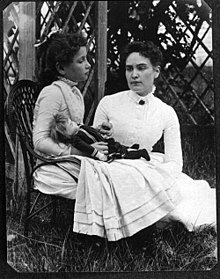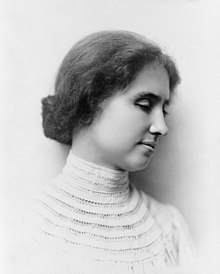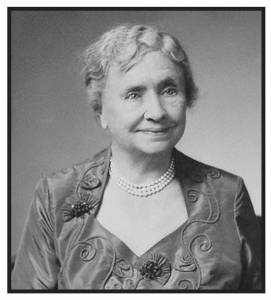I wonder how many of my 4B classmates at Kiest Elementary School in Dallas in 1963 are still alive. And of those who are, do they remember SRA? The acronym stands for Science Research Associates. It was a pedagogically sound system of getting students to read, and then checking their vocabulary and comprehension, moving them up level by level. Mrs. Boley, the 4B teacher, made those decisions, just as she filled out our report cards (along with pithy comments about cognitive abilities, academic growth, deportment and so on) every six weeks. Our reading assignments came from a color-coded box, but there was another facet of SRA. We were given a list of book titles, each accompanied by a precis. Books—perhaps more properly called booklets—could be bought for a nominal price. In at least one instance, I took the plunge and purchased a biography of Helen Keller. It probably cost no more than a dollar.
One little biography
SRA might have had a role in turning me into a reader, and if so I should send a letter of gratitude to its current president; in fact, it has been bought and taken over by several much bigger entities such as IBM and McGraw-Hill. I am fully aware that reading, especially of books, is becoming less popular all the time and is considered passé and uncool in some quarters. I know from personal experience that this is not so, and I am backed up here by no less an authority than Theodor Geissel, a.k.a. Dr. Seuss: “The more that you read, the more things you will know. The more that you learn, the more places you’ll go.”
The cartoonish Horton Hears a Who, The Cat in the Hat and How the Grinch Stole Christmas (three Seuss classics) were even less substantial than the little book I bought from SRA about Keller, and it was a sanitized version of her life. Of course, it would have told how she lost her sight and hearing at 19 months; was a terror to her family until Anne Sullivan arrived and taught her the meaning of the word “water” at a pump behind the family’s house in Tuscumbia, Alabama; became an inspiration and symbol of hope to blind and deaf people all over the world; met and charmed presidents, kings and queens; earned a degree from Radcliffe College; and very much more. It’s hard not to love a woman who uttered such words as “The best and most beautiful things in this world cannot be seen or even heard, but must be felt with the heart.”
months; was a terror to her family until Anne Sullivan arrived and taught her the meaning of the word “water” at a pump behind the family’s house in Tuscumbia, Alabama; became an inspiration and symbol of hope to blind and deaf people all over the world; met and charmed presidents, kings and queens; earned a degree from Radcliffe College; and very much more. It’s hard not to love a woman who uttered such words as “The best and most beautiful things in this world cannot be seen or even heard, but must be felt with the heart.”
Still in the reading mode? You know I am. I recently completed Dorothy Herrmann’s Helen Keller / A Life. This book is far more current, is written for an educated, adult audience and does not shy away from sensitive issues. For one thing, Keller was an activist, and unapologetically so. A co-founder of the American Civil Liberties Union, she boldly came out for birth control, female suffrage, socialism and workers’ rights. Some people down in Bama were not happy when she insisted on the equality of all persons, regardless of race; the noted black scholar W.E.B. Du Bois praised her and followed her career closely. Mark Twain and Winston Churchill were two of her biggest and most enthusiastic supporters.
Busting stereotypes
Oh, Keller had critics and doubters. Some people would have preferred her to be more like Laura Bridgman (1829-1889). She, too, was completely deaf and blind but managed to learn how to communicate by use of hands and fingers. Bridgman, however, did not have such a dedicated teacher as Keller did in Sullivan, nor did she make the dramatic advances that wowed “normal” people. The emaciated Bridgman looked the part of Whistler’s mother and spent much of her time alone, knitting.  Keller emphatically did not want to be a knitter. “Sewing and crocheting are inventions of the devil,” she once said. “I’d rather break stones on the king’s highway than hem a handkerchief.”
Keller emphatically did not want to be a knitter. “Sewing and crocheting are inventions of the devil,” she once said. “I’d rather break stones on the king’s highway than hem a handkerchief.”
As indicated above, Keller was a woman of ideas and opinions, and did not hesitate to share them. She wrote 12 books, acted in a couple of movies and spent four profitable years on vaudeville. During her youth, she was—forgive me for saying it—a real looker. A beautiful face, lavish brown hair and a voluptuous body drew male attention. (The clear, blue prosthetic eyes she got at age 30 made her all the more attractive.) The Victorian era in which Keller grew up could not bear to think of a severely disabled person getting married, engaging in sex and having children, but that is just what Keller desired—so she informed Sullivan and her successor, Polly Thomson. “In the odor of young men, there is something elemental, as of fire, storm and salt sea,” she once wrote. “It pulsates with buoyancy and desire.” Now is that a sensual line or what? Although one suitor, Peter Fagan, surreptitiously courted her (there were kisses and quite possibly more) he was sent packing when Sullivan and Keller’s mother found out about it.
Like the rest of us
Helen Keller was a complicated person, with foibles and inconsistencies, just like the rest of us. She rebelled against those who saw her in a one-dimensional way, and yet she benefited from wealthy benefactors (Alexander Graham Bell, Henry Rogers, James S. Adams and Andrew Carnegie among them) who often did just that. She was sometimes unkind toward family members, held grudges that lasted for decades and could be distant toward friends. She liked her creature comforts. The 49-year relationship between Keller and Sullivan was powerful and occasionally turbulent. Some naysayers painted Sullivan as a Svengali—an unfair accusation, in my view, since she essentially gave her entire professional life to Keller. While Sullivan had a quicksilver personality, her dedication to her charge cannot be seriously doubted.
who often did just that. She was sometimes unkind toward family members, held grudges that lasted for decades and could be distant toward friends. She liked her creature comforts. The 49-year relationship between Keller and Sullivan was powerful and occasionally turbulent. Some naysayers painted Sullivan as a Svengali—an unfair accusation, in my view, since she essentially gave her entire professional life to Keller. While Sullivan had a quicksilver personality, her dedication to her charge cannot be seriously doubted.
The little book I bought and read in 1963, five years before Keller’s death, got some things right. But its portrayal of Keller as prim and proper, virginal and saintly, and above all passive was wide of the mark. The real flesh-and-blood woman was far more interesting than that.

4 Comments
Top-notch essay about a superb duo in American history. As a teacher, I had enough implacable students but for Sullivan to accomplish what she did with Keller is downright saintly.
P.S. I, too, was treated to SRA while at Gompers JHS in Joliet from 1962-1964. I was fascinated by the colors in the box of booklets and eagerly attempted to move up the scale as rapidly as I could. RIP, SRA.
Like you, I remember those colors….red, yellow, green, etc. Somehow it meant learning and with that came true pleasure. In the present case, the pleasure of knowing about Helen Keller.
Excellent article. I don’t recall SRA but we must have had it at Reinhardt. Maybe that’s where I picked up my love of science.
The Helen Keller prorated was touching. What a remarkable woman and I loved your quotation of her concerning how she was struck by young men.
Thanks, Lt. Nietmann!!!
Add Comment